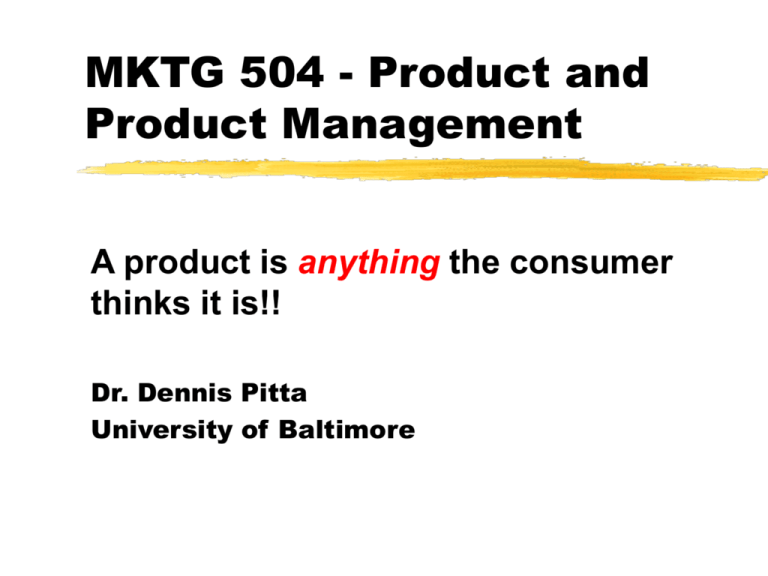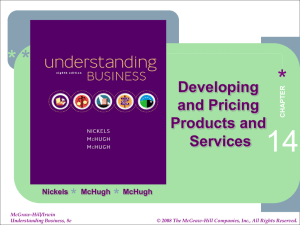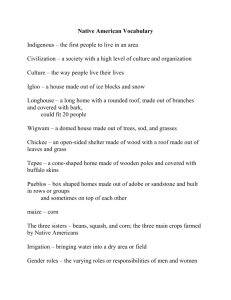Lecture Six
advertisement

MKTG 504 - Product and Product Management A product is anything the consumer thinks it is!! Dr. Dennis Pitta University of Baltimore PRODUCT A complex bundle of attributes Most important element of the marketing mix. Charles Revson: “In the factory we make cosmetics, in the store we sell _HOPE” Elmer Wheeler: “Don’t sell the steak, sell the SIZZLE.” Product: Not limited to goods - it is goods, ideas, services, people, organizations, places. Product: = Physical product + other tangible components + intangible components + social impact Product Component Examples: Physical good: wood, plastic, chemical (shaver) Other tangibles: service, brand name, close shave, package Intangible: Eminem likes it Social Impact: More young men are clean shaven What is the product? University degree Politician You - Yourself as a job candidate Really what is product? ANYTHING A CONSUMER THINKS IT IS Examples of what people think Bubble-Yum Bubble Gum - MADE WITH SPIDER’S EGGS Kentucky Fried RAT WORMS in Big Macs Product Life Cycle A dynamic model of how product changes over time. Importance: different product characteristics at each stage: Lead to different marketing strategies Emphasize different combinations of the 4 P’s..... Sales & profits ($) Sales & Profit Life Cycles Introduction Growth Maturity Time Decline Important Characteristics => PLC SALES RATE OF SALES GROWTH # OF COMPETITORS PRODUCT PROMOTIONAL STRATEGY PRICING DISTRIBUTION Tracking the PLC over time: PETRIFICATION SALES RATE OF SALES GROWTH # OF COMPETITORS PRODUCT PROMOTIONAL STRATEGY PRICING DISTRIBUTION __________ __________ __________ __________ __________ __________ __________ Bucky Beaver and Ipana Examples of Products in Each PLC Stage Intro: DVD-R DRIVES Growth: DVD’S Shakeout: PC’S Mat-Sat: VCR’S Decline: RECORD CHANGERS Petrification: IPANA TOOTHPASTE CLASSIFYING PRODUCTS Product Category (Class): Automobile/container/Timepiece Product Form: Convertible/Tin Can/Watch - Wrist Product Item (brand): Ford Probe/American Can/Seiko How much effort would you spend buying chewing gum? How much effort would you spend buying a refrigerator? How much effort would you spend buying a one of a kind masterpiece by Rembrandt? CLASSIFICATION OF CONSUMER GOODS CONVENIENCE SHOPPING SPECIALTY UNSOUGHT Consumer-Goods Classification Convenience Products Shopping Products Buy frequently & immediately > Low priced > Many purchase locations > Includes: • Staple goods • Impulse goods • Emergency goods Buy less frequently > Gather product information > Fewer purchase locations > Compare for: • Suitability & Quality • Price & Style Specialty Products Unsought Products Special purchase efforts > Unique characteristics > Brand identification > Few purchase locations New innovations > Products consumers don’t want to think about. >Require much advertising & personal selling CLASSIFICATION OF CONSUMER GOODS CONVENIENCE PURCHASED WITH A MINIMUM OF EFFORT SHOPPING HEAVY COMPARISON OF PRICE, QUALITY, AND STYLE SPECIALITY VERY STRONG BRAND PREFERENCE: SPECIAL TIME AND EFFORT - PRICE NOT VERY IMPORTANT CLASSIFICATION OF CONSUMER GOODS UNSOUGHT This is a difficult product. Examples: Life insurance to young unmarried men Umbrellas to young unmarried men Vacuum cleaners to young unmarried men….. Chain Saws to young unmarried women…. Product Mix Width - number of different product lines Length - total number of items within the lines Depth - number of versions of each product Product Mix all the product lines offered Product Mix Strategy Decisions made at three levels: 1 Product ITEM (specific version) - keep or drop. 2 Product LINE (group of related products) - deepen or shorten. 3 Product MIX (composite of all products) - ‘what markets to be in’ Product Mix Strategy 1 WIDTH - How many different product line there are within the company. (Sears - WIDE - Circuit City - NOT AS WIDE; Britches - NARROW) Product Mix Strategy 2 DEPTH - The average number of items offered by the company within each line. Maxwell House Coffee - DEEP; Sears NOT SO DEEP The LIMITED STORE - How deep? Product Mix Strategy 3 CONSISTENCY - Relationship of products to one another - in end use. (i.e., INTERACTION - together) G.E.; XEROX - GOOD CONSISTENCY HUNT-WESSON -Paint, Matches, Food Product Mix Strategy A continual addition of new products and deletions of old to meet the company’s needs. Something new... New Product Development Product Innovation Process (New Product Development) Starts with a product idea Let’s take a North American summer staple - corn How does one hold corn on the cob? How does one hold corn on the cob? With a corn holder!! What does corn look like? One end is pointed One end is blunt What is a problem with ordinary corn holders? It is tough to get them out of an ear that has been eaten One sticks in the blunt end Getting it out is often messy The Solution? The Pitta Improved Cornholder (PIC) St ainless st eel pins Plunger Spring The Pit t a Improved Cornholder PIC Product Benefits Easy to remove (the one stuck in the blunt end of the ear comes off easily) Fun at parties - (dodge the flying corn cob) Saves laundry (less mess, less laundry) Where would someone get this idea? …from eating corn!! Product Innovation Process 1 IDEA GENERATION Sources: Organization Secondary sources: Patent Office; Idea Mills; Independent Inventors Consumers (e.g., Kleenex) Who thought of the product: Army nurses (after WWI) Thought cellulose fiber bandages might be useful ‘Facial Tissue’ A product is anything someone thinks it is…. When was the last time someone blew his or her ‘face’? We use Kleenex as a disposable handkerchief! Is it a facial tissue?? Product Innovation Process Stage 2 2 SCREENING Critical evaluation Possible problems: Rejecting a Good Product (Type 1 Error) Accepting a Bad Product as a good one (Type II Error) (I would hate to make this type testing Handgrenades) The Pitta Improved Cornholder (PIC) Critical Evaluation We asked friends We asked our mothers We asked our wives We demonstrated the PIC to strangers... Product Innovation Process Stage 3 3 ECONOMIC ANALYSIS Forecast Sales Return on Investment Effect on Product Line Cash Flow Profit Breakeven Analysis The Pitta Improved Cornholder (PIC) Economic Analysis Breakeven Analysis The first cornholder cost $27,000 The second cost $.02 Probable retail price for two=> $1 Probable wholesale price for two =>$.50 (PIC) Breakeven Analysis Calculates # of units to be sold at a price to just breakeven Fixed Cost = $27,000 Variable Cost (per unit) = $.20 (2 holders, packaging, overhead) Price (wholesale) = $.50 per unit (PIC) Breakeven Analysis BE = FC/(P-VC) = units BE (in units) = $27,000/(.50-.20) = 90,000 units Forget it! Product Innovation Process 4 DEVELOPMENT Determining Product Benefits Creating the Package, Brand Name 5 TEST MARKETING (Small Scale Introduction) Marketing Plan 6 COMMERCIALIZATION (Roll Out) MKTG 504 - Product and Product Management Commercialization – the last stage of the Product Innovation Process Dr. Dennis Pitta University of Baltimore COMMERCIALIZATION A public offering of the product to the marketplace Two forms Commercialization - Nationwide Roll Out – limited geographic areas – one at a time Roll out – an example Tio Sancho rolled out its new nonfracturing taco shell against the largest Tex-Mex food manufacturer – Old El Paso. Tio Sancho was small with few resources Roll Out vs. Commercialization Commercialization Roll Out very Costly Complex Hits the whole market simultaneously (Comprehensive) Less expensive Simpler Risks being copied in the regions not covered Adopter Categorization of the Basis of Relative Time of Adoption of Innovations 34% Early majority 2 1/2% Innovators 13 1/2% Early adopters 34% Late majority 16% Laggards Time of adoption innovations What is a Brand? User Culture Features Personality Benefits Advantages Good Brand Names: Distinctive Suggest Product Qualities Suggest Product Benefits Lack Poor Foreign Language Meanings Easy to: Pronounce Recognize Remember Product Differentiation Form Features Performance Durability Reliability Repairability Quality Style Conformance Quality Design Maturity Stage Market Modification Product Modification Marketing-Mix Modification Decline Stage Increase investment Resolve uncertainties - stable investment Selective niches Harvesting Divesting Market Evolution Emergence Growth Maturity Decline Upcoming Topic PRICE







